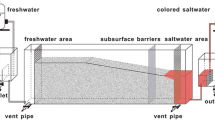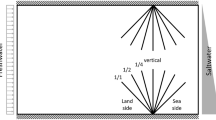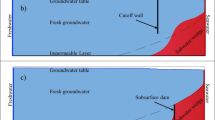Abstract
Saltwater intrusion (SWI) increases salinity of aquifers and depletion of groundwater resources in coastal aquifers. Different methods have been used to control SWI in the coastal aquifers in order to protect groundwater. In this paper, applicability of physical subsurface barriers (PSB) methods to control SWI in the Biscayne aquifer in Florida, USA, is studied. Numerical models have been developed to study and compare performance of two types of the PSB namely cutoff wall and subsurface dam for SWI control. The developed numerical models have been verified through simulation of benchmark examples and then have been used to simulate a semi-hypothetical case study relying on hydrogeological data measured in the Biscayne aquifer. Different scenarios of barriers depths, locations, and permeability have been analyzed. The results indicated that the PSB can effectively control the intrusion of saline into coastal aquifers. However, cutoff wall gave higher retardation than sub-surface dams.































Similar content being viewed by others
References
Abdelaty I, Abd-Elhamid HF, Javadi A (2016) Numerical analysis of the effects of changing hydraulic parameters on saltwater intrusion in coastal aquifers. Eng Computation J 33(8):2546–2564
Abd-Elhamid HF, Javadi AA (2008) Mathematical models to control saltwater intrusion in coastal aquifer. Proceeding of GeoCongress, New Orleans, Louisiana, USA
Abd-Elhamid HF (2010) A simulation-optimization model to study the control of seawater intrusion in coastal aquifers‖. PhD Thesis, University of Exeter, UK
Abdoulhalik A, Ahmed A, Hamill GA (2017) A new physical barrier system for seawater intrusion control. J Hydrol 549:416–427
Abiy AZ, Melesse AM, Abtew W, Whitman D (2019) Rainfall trend and variability in Southeast Florida: implications for freshwater availability in the Everglades. PLoS One 14(2):e0212008. https://doi.org/10.1371/journal.pone.0212008
Abtew W, Trimble P (2010) El Niño-southern oscillation link to south florida hydrology and water management applications. Water Resour Manag 24(15):4255–4271
Barsi MH (2001) Two new methods for optimal design of subsurface barrier to control seawater intrusion. PhD Thesis, University of Manitoba, Winnipeg, Manitoba, Canada
Bear J, Cheng AHD (2010) Modeling groundwater flow and contaminant transport, 1st edition ed. Springer, Manhattan, New York City
Bear J, Cheng AH, Sorek S, Quazar D, Herrera I (1999) Seawater intrusion in coastal aquifers, concepts, methods and practices. Kluwer Academic publisher, Dordrecht, The Netherlands. isbn:0-7923-5573-3
Bear J, Cheng A H D (1999) Introduction. In: Seawater intrusion in coastal aquifers – concepts, methods and practices. Sorek, S, Ouazar, D, Herrera, I (Eds.). Kluwer Academic Publishers. Dordrecht, The Netherlands
Byrne MJ (1999) Groundwater nutrient loading in Biscayne Bay. MSc Thesis, Florida International University, Biscayne National Park, Florida: Miami
Beaujean J, Nguyen F, Kemna A, Antonsson A, Engesgaard P (2014) Calibration of seawater intrusion models: Inverse parameter estimation using surface electrical resistivity tomography and borehole data. Water Resour Res:6828–6849
Chang SW (2012) Dynamics of saltwater intrusion processes in saturated porous media systems. Auburn University, Auburn, Alabama
Cheng J, Strobl RO, Yeh G, Lin H, Choi W (1998) Modelling of 2D density-dependant flow and transport in the subsurface. J Hydrol Eng 3(4):248–257
FDEP, Florida Department of Environmental Protection (2011). Groundwater in Florida. FDEP, Tallahassee, Florida. <http://www.dep.state.fl.us/water/ groundwater/index.htm>
Frind EO (1982) Simulation of long-term transient density-dependent transport in groundwater. Water Resour Res 5(2):3–88
Ghyben B W (1889) Nota in Verband Met de Voorgenomen put Boring Nabij Amsterdam. Tydscrift Van Het Koninkyky Institute Van Ingenieurs, the Hahue, the Netherlands
Harne S, Chaube UC, Sharma S, Sharma P, Parkhya S (2006) Mathematical modelling of salt water transport and its control in groundwater. Nat Sci 4:32–39
Hamza KI (2004) Numerical analysis of saltwater upconing below a pumping well. Proceeding of the 18th Salt Water Intrusion Meeting. Cartagena, Spain
Henry HR (1964) Effect of dispersion on salt encroachment in coastal aquifers. U.S. Geol. Surv. Water-Supply Pap 1613-C:70–84
Herzberg A (1901) Die wasserversorgung Einnger Nordsecbader. J Gasbeleuchtung U. Wasservesurg, Jahrg 44, Munich, Germany, 815-819
Iribara V, Carrera J, Custodio E, Medina A (1997) Inverse modelling of seawater intrusion in the Llobregat delta deep aquifer. J Hydrol 198:226–244
Karol RH (1990) Chemical Grouting. Marcel Dekker, New York
Langevin CD, Thorne DT, Dausman AM, Sukop MC, Guo W (2007) SEAWAT Version 4: a computer program for simulation of multi-species solute and heat transport: U.S. Geological Survey Techniques and Methods, book 6, Chapter A22, p 39
Langevin C D (2001) Simulation of ground-water discharge to Biscayne Bay, Southeastern Florida. U.S. geological survey, water-resources investigations report 00-4251. Tallahassee, Florida
Lee CH, Cheng RTS (1974) On seawater encroachment in coastal aquifer. Water Resour Res 10(5):1039–1043
James G, Hiebert R, Warwood B and Cunningham A (2001) Subsurface biofilm for controlling saltwater intrusion. Proceeding of the 1st international conference and workshop on saltwater intrusion and coastal aquifers, monitoring, modelling, and management, Morocco
Nezhad MM (2010) Stochastic finite element modelling of flow and solute transport in dual domain system. PhD Thesis, University of Exeter, England
Nezhad MM, Javadi AA, Abbasi F (2011) Stochastic finite element modelling of water flow in variably saturated heterogeneous soils. Int J Numer Anal Met 35(12):1389–1408
Nishigaki M, Kankam-Yeboah K, Komatsu M (2004) Underground dam technology in some parts of the world. J Groundw Hydrol 46(2):113–130
Marella R, Berndt M. (2005) Water withdrawals and trends from the Floridan aquifer system in the southeastern United States, 1950–2000. USGS Geol Surv Circ 1278. ;http://pubs.water.usgs.gov/cir1278/pdf/cir1278.pdf
Pearlman L (1999) Subsurface containment and monitoring systems: barriers and beyond. U.S. EPA National Network of Environmental Management Studies, Washington, DC
Pinder GF, Cooper HH (1970) A numerical technique for calculating the transient position of the saltwater front. Water Resour Res 6(3):875–882
Praveena SM, Lin CY, Aris AZ, Abdullah MH (2010) Groundwater assessment at Manukan Island, Sabah: Multidisplinary approaches. Nat Resour Res 19(4):279–291
Praveena SM, Abdullah MH, Aris AZ, Lin CY, Bidin K (2011) Numerical modeling of seawater intrusion in Manukan Island’s aquifer. World Appl Sci J 14:1–7
Roger LJ, Kazuro M, Kei N (2011) Effects of recharge and flow barrier on seawater intrusion. Groundwater 49(2):239–249
Ranjan P, Kazama S, Sawamoto M (2006) Effects of climate change on coastal fresh groundwater resources. Glob Environ Chang 16(4):388–399
Renken RA, Dixon J, Koehmstedt J, Lietz AC, Ishman S, Marella R (2005) Impact of anthropogenic development on coastal ground-water hydrology in Southeastern Florida, 1900–2000. US Geol Surv Circ (1275):1–87
Sakr S A (1992) Vertically integrated two-dimensional finite element model of seawater intrusion in aquifers. MSc. Thesis, Colorado State University. Fort Collins, Co. 80521
Segol G, Pinder GF, Gray WG (1975) A Galerkin finite element technique for calculating the transition position of the saltwater front. Water Resour Res 11(2):343–347
Strack ODL, Stoeckl L, Damm K, Houben G, Ausk BK, de Lange WJ (2016) Reduction of saltwater intrusion by modifying hydraulic conductivity. Water Resour Res 52(9):6978–6988
SVCHEM Cpde (2018) SoilVision Systems Ltd. Saskatoon, Saskatchewan, Canada https://soilvision.com
Sklar F, McVoy C, Van Zee R, Gawlik D, Swift D (1999) Park W (1999) Chapter 2: Hydrologic needs: the effects of altered hydrology on the Everglades. Everglades Interim Rep 2:1–68
Swain E (2012) Stochastic analyses to identify wellfield withdrawal effects on surface-water and groundwater in Miami-Dade County. Florida J Environ Manage 113:15–21
Taylor A, Hulme P, Hughes A and Foot S (2001) Benchmarking of variable density model codes against Henry’s problem. Proceeding of the 1st international conference and workshop on saltwater intrusion and coastal aquifers, monitoring, modelling, and management, Morocco
Todd K (1974) Saltwater intrusion and its control, water technology/ resources. J Am Water Works Assoc 66(3):180–187
Voss CI, Souza WR (1987) Variable density flow and solute transport simulation of regional aquifers containing a narrow fresh-water-saltwater transition zone. Water Resour Res 23:1851–1866
Voss CF, Einberger C (1994) M, and Matalucci RV. Evaluation of two new grouts for constructing subsurface barriers. hanford symposium on health and the environment, Pasco, Washington
Zwick PD, Carr MH (2006) Florida 2060. GeoPlan Center, University of Florida, Gainesville, Florida, A population distribution scenario for the State of Florida
Author information
Authors and Affiliations
Corresponding author
Additional information
Responsible editor: Marcus Schulz
Publisher’s note
Springer Nature remains neutral with regard to jurisdictional claims in published maps and institutional affiliations.
Rights and permissions
About this article
Cite this article
Abd-Elaty, I., Abd-Elhamid, H.F. & Nezhad, M.M. Numerical analysis of physical barriers systems efficiency in controlling saltwater intrusion in coastal aquifers. Environ Sci Pollut Res 26, 35882–35899 (2019). https://doi.org/10.1007/s11356-019-06725-3
Received:
Accepted:
Published:
Issue Date:
DOI: https://doi.org/10.1007/s11356-019-06725-3




